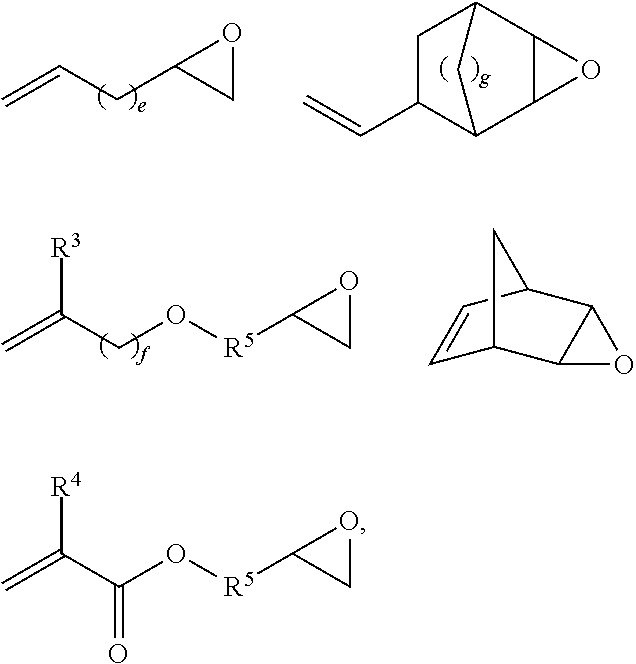Novel polysiloxanes having betaine groups, production and use thereof
a technology of polysiloxanes and betaine groups, applied in the field of new polysiloxanes having betaine groups, production and use thereof, can solve the problems of hair damage, greater or lesser damage to the hair structure, and amino-functional siloxanes likewise have greatly viscosity-reducing properties
- Summary
- Abstract
- Description
- Claims
- Application Information
AI Technical Summary
Benefits of technology
Problems solved by technology
Method used
Image
Examples
example 1
Preparation of a Polysiloxane with Betaine Modification
[0108]In a four-neck flask fitted with stirrer, reflux condenser, thermometer and dropping funnel, 65.0 g (2.5 mmol) of an α,ω-divinylsiloxane of the general formula CH2═CH—SiMe2O—(SiMe2O)348—SiMe2—CH═CH2 and 74.2 g (650 mmol) of allyl glycidyl ether (AGE) were dissolved in 200 ml of toluene, heated to 100° C. and admixed with 4.3 mg of (NH3)2PtCl2. 141.5 g (50.0 mmol or 500.0 mmol of SiH groups) of an SiH-functional siloxane of the general formula Me3SiO—(SiMe2O)28(SiMeHO)10SiMe3 were added dropwise with stirring and the reaction mixture was reacted for 2 h at 100° C. to an SiH conversion of >95%. The reaction product was distilled for 2 h at 120° C. and a vacuum of 1 mbar in order to separate off toluene, excess AGE and other volatile secondary constituents.
[0109]The slightly opaque epoxy siloxane product was then dissolved in 300 ml of isopropanol, admixed with 51.6 g (500 mmol) of N,N-dimethylglycine and heated at 80° C. for...
example 2
Preparation of a Polysiloxane with Betaine Modification
[0110]In a four-neck flask fitted with stirrer, reflux condenser, thermometer and dropping funnel, 65.0 g (2.5 mmol) of a divinylsiloxane of the general formula CH2═CH—SiMe2O—(SiMe2O)348—SiMe2—CH═CH2 and 74.2 g (650 mmol) of allyl glycidyl ether (AGE) were dissolved in 250 ml of toluene, heated to 100° C. and admixed with 4.9 mg of (NH3)2PtCl2. 178.6 g (50.0 mmol or 500.0 mmol of SiH) of an SiH-functional siloxane of the general formula Me3SiO—(SiMe2O)38(SiMeHO)10SiMe3 were added dropwise with stirring and the reaction mixture was reacted for 3 h at 110° C. to an SiH conversion of >95%. The reaction product was distilled for 2 h at 120° C. and a vacuum of 1 mbar in order to separate off toluene, excess AGE and other volatile secondary constituents. The slightly opaque epoxy siloxane product was then dissolved in 300 ml of isopropanol, admixed with 51.6 g (500 mmol) of N,N-dimethylglycine and heated for 6 h at 80° C. 352.1 g of p...
example 3
Preparation of a Polysiloxane with Betaine and Polyether Modification
[0111]In a four-neck flask fitted with stirrer, reflux condenser, thermometer and dropping funnel, 141.5 g (50.0 mmol or 500.0 mmol of SiH) of an SiH-functional siloxane of the general formula Me3SiO—(SiMe2O)28(SiMeHO)10SiMe3 were introduced as initial charge, heated to 120° C. and admixed with 11.6 mg of (cyclohexene)2Pt2Cl4 and 0.32 g N-ethyl-N,N-diisopropylamine. 34.2 g (300 mmol) of allyl glycidyl ether (AGE) were added dropwise with stirring and left being stirred for 1 h at 120° C. Then, 65.0 g (2.5 mmol) of a divinylsiloxane of the general formula CH2═CH—SiMe2O—(SiMe2O)348—SiMe2—CH═CH2 were added and the mixture was reacted for a further hour at 120° C. before 398.7 g (350 mmol) of an allyl polyether of the general formula H2C=CH—CH2—(OCH2CH2)15—(OCH2CH(CH3))7—OCH3 were added dropwise. Following the addition of a further 3.5 mg of (cyclohexene)2Pt2Cl4, after 3 h at 120° C., an SiH conversion of >95% was achi...
PUM
| Property | Measurement | Unit |
|---|---|---|
| mechanical stresses | aaaaa | aaaaa |
| structure | aaaaa | aaaaa |
| surface properties | aaaaa | aaaaa |
Abstract
Description
Claims
Application Information
 Login to View More
Login to View More - R&D
- Intellectual Property
- Life Sciences
- Materials
- Tech Scout
- Unparalleled Data Quality
- Higher Quality Content
- 60% Fewer Hallucinations
Browse by: Latest US Patents, China's latest patents, Technical Efficacy Thesaurus, Application Domain, Technology Topic, Popular Technical Reports.
© 2025 PatSnap. All rights reserved.Legal|Privacy policy|Modern Slavery Act Transparency Statement|Sitemap|About US| Contact US: help@patsnap.com



